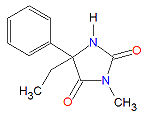Mephenytoin: Difference between revisions
Jump to navigation
Jump to search

imported>David E. Volk (New page: {{subpages}} {{Chem infobox |align=right |image=center|thumb|150px |width=150px |molname=mephenytoin |synonyms= '''Mesantoin®''' |molformula= |molmass= |use...) |
imported>David E. Volk m (CZMed) |
||
| (2 intermediate revisions by the same user not shown) | |||
| Line 6: | Line 6: | ||
|width=150px | |width=150px | ||
|molname=mephenytoin | |molname=mephenytoin | ||
|synonyms= | |synonyms= mephentoin, methyl hydantoin, methylphenetoin | ||
|molformula= | |molformula= C<sub>12</sub>H<sub>14</sub>N<sub>2</sub>O<sub>2</sub> | ||
|molmass= | |molmass= 218.2518 | ||
|uses=anti-seizure drug | |uses=anti-seizure drug | ||
|properties= | |properties= | ||
|hazards= | |hazards= | ||
|iupac=<small>'''3-methyl | |iupac=<small>'''5-ethyl-3-methyl-5-phenylimidazolidine-2,4-dione'''</small> | ||
|casnumber= | |casnumber= 50-12-4 | ||
}} | }} | ||
'''Mephenytoin''' ('''Mesantoin®''') is | '''Mephenytoin''' ('''Mesantoin®''') is an anticonvulsant medication used to treat [[epilepsy]] and it is particularly effective in [[tonic-clonic epilepsy]] . Its common chemical name is '''3-methyl 5,5-phenyl-ethyl-hydantoin''' and its IUPAC chemical name is '''5-ethyl-3-methyl-5-phenylimidazolidine-2,4-dione'''. It has pharmacological effects similar to [[phenytoin]] and the [[barbiturate]]s. | ||
== Mechanism of action == | |||
The mechanism of action of mephenytoin is not definitely known, but extensive research strongly suggests that its main mechanism is to block frequency-, use- and voltage-dependent neuronal sodium channels, and therefore limit repetitive firing of action potentials.<ref>{{cite web|url=http://www.drugbank.ca/cgi-bin/getCard.cgi?CARD=DB00532|accessdate=062508|title=DrugBank page for Mephenytoin}}</ref> | |||
== Synonyms and brand names == | |||
===Synonyms=== | |||
*Mephentoin | |||
*Methyl Hydantoin | |||
*Methylphenetoin | |||
===Brand Names === | |||
*Epiazin® | |||
*Gerot-Epilan® | |||
*Insulton® | |||
*Mesdontoin® | |||
*Mesontoin® | |||
*Methoin® | |||
*Metydan® | |||
*Phenantoin® | |||
*Sacerno® | |||
*Sedantional® | |||
*Sedantoin® | |||
*Sedantoinal® | |||
*Triantoin® | |||
== External links == | == External links == | ||
{{ | {{CZMed}} | ||
== References == | |||
<references/> | |||
Revision as of 13:59, 25 June 2008
|
| |||||||
| mephenytoin | |||||||
| |||||||
| Uses: | anti-seizure drug | ||||||
| Properties: | |||||||
| Hazards: | |||||||
| |||||||
Mephenytoin (Mesantoin®) is an anticonvulsant medication used to treat epilepsy and it is particularly effective in tonic-clonic epilepsy . Its common chemical name is 3-methyl 5,5-phenyl-ethyl-hydantoin and its IUPAC chemical name is 5-ethyl-3-methyl-5-phenylimidazolidine-2,4-dione. It has pharmacological effects similar to phenytoin and the barbiturates.
Mechanism of action
The mechanism of action of mephenytoin is not definitely known, but extensive research strongly suggests that its main mechanism is to block frequency-, use- and voltage-dependent neuronal sodium channels, and therefore limit repetitive firing of action potentials.[1]
Synonyms and brand names
Synonyms
- Mephentoin
- Methyl Hydantoin
- Methylphenetoin
Brand Names
- Epiazin®
- Gerot-Epilan®
- Insulton®
- Mesdontoin®
- Mesontoin®
- Methoin®
- Metydan®
- Phenantoin®
- Sacerno®
- Sedantional®
- Sedantoin®
- Sedantoinal®
- Triantoin®
External links
The most up-to-date information about Mephenytoin and other drugs can be found at the following sites.
- Mephenytoin - FDA approved drug information (drug label) from DailyMed (U.S. National Library of Medicine).
- Mephenytoin - Drug information for consumers from MedlinePlus (U.S. National Library of Medicine).
- Mephenytoin - Detailed information from DrugBank.
References
- ↑ DrugBank page for Mephenytoin. Retrieved on 062508.
